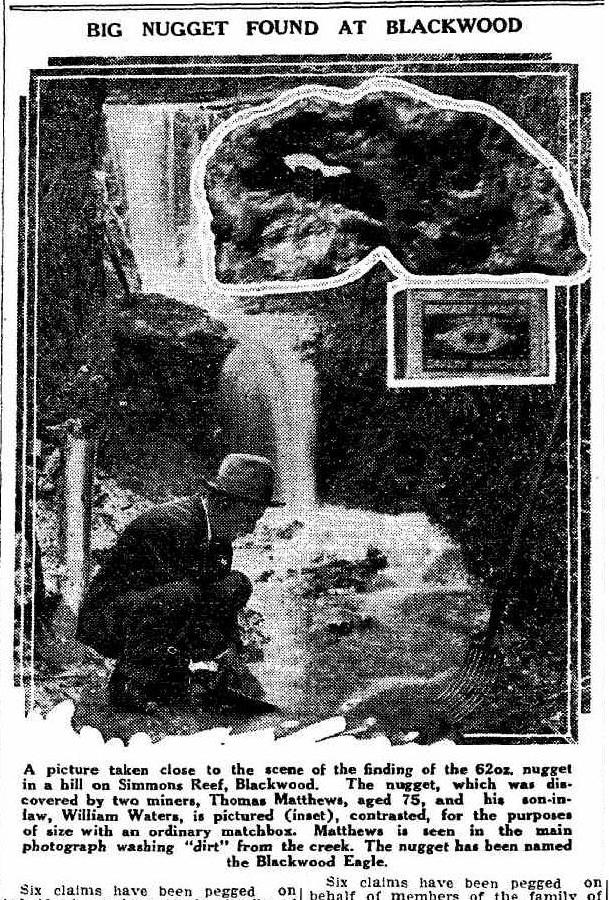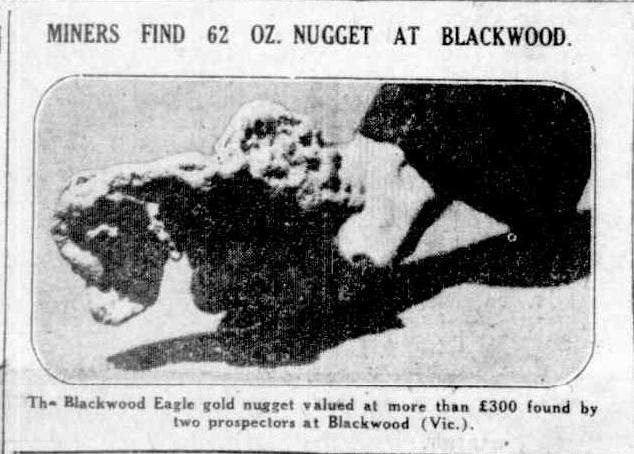Information courtesy of Margot Hitchcock, Historian for the Blackwood Historical Society. May 2019. ©
The very rich alluvial gold of the early days was chiefly found in the Lerderderg River and its tributaries, and the Nuggety, Long, Yankee, Jackson’s Dead Horse, Whipstick, Back and Kangaroo Creeks. The sinking was very shallow, averaging about 20 feet. The old mining registers hold records of many large nuggets discovered. In Long Gully a nugget weighing 60 ounces was found. The workings in Shicer Gully yielded several nuggets weighing 42 ounces., 46 ounces.
A nugget of 62 ½ ounces was found in 1931 by Thomas Matthews and his son-in-law William Waters and known as the ‘Blackwood Eagle’ in Shicer Gully. This nugget created some publicity in the Melbourne papers, which was in the grip of the depression, and resulted in a minor ‘rush’ to the area when 30 claims were pegged out in one day.
https://trove.nla.gov.au/newspaper/article/223192657?searchTerm=big%20nugget%20found%20blackwood%20thomas%20matthews&searchLimits=l-state=Victoria
Weekly Times (Melbourne, Saturday 21 February 1931 – BIG NUGGET FOUND AT BLACKWOOD – A picture taken close to the scene of the finding of the 62oz. nugget in a hill on Simmons Reef, Blackwood. The nugget, which was discovered by two miners, Thomas Matthews, aged 75, and his son-in-law, William Waters, is pictured (inset), contrasted, for the purposes of size with an ordinary matchbox. Matthews is seen in the main photograph washing “dirt” from the creek. The nugget has been named the Blackwood Eagle.
Article found in Weekly times about Tom Matthews finding the Blackwood Eagle Nugget in 1931. ©
A nugget of 62 ½ ounces was found in 1931 by Thomas Matthews and his son-in-law William Waters and known as the ‘Blackwood Eagle’ in Shicer Gully. ©
Newspaper article showing Thomas Matthews, aged 75, and his son-in-law, William Waters in Shicer Gully, Simmons Reef, where they found the nugget in 1931. ©
Australasian (Melbourne), Saturday 21 February 1931.
NUGGET WORTH £311.
A nugget of gold weighing 62oz. 4dwt, was found in a gully close to Simmon’s reef, near the township of Blackwood (V.) on February 11 by Messrs.Thomas Matthews, aged 78 years, and William Waters, his son-in-law.
Mr. Waters pierced the nugget with the point of his pick about 8in. below the surface of the ground. The nugget, which is believed to be worth about £311. is considered the largest ever found in the district.
The men have been working in the district for many months with only moderate success, and had almost decided to abandon their claim when the nugget was found. Many parties are searching the district.
The Blackwood Historical Society has a gold painted plaster cast of this nugget on show in their museum, which was given to them by Molly Waters from the family who found it. Pictured here with an egg cup to show size by comparison.©
I did some further research on Thomas Matthews who found the big Blackwood Eagle nugget in 1931 when he was age 75 yrs. A newspaper report when he died said – Age – Monday 29 April 1935,
ABOUT PEOPLE. ‘ Mr. Thomas Mathews, one of the early pioneers of Blackwood, died on Saturday, aged 79 years. He was born at Blackwood and had lived there, practically all his life. He was the finder of the ‘Golden Eagle’ nugget. A widow, two sons and two daughters survive’. so I checked my Digger birth records and found he was born at Blackwood in 1856 with his father being William Matthews and mother Catherine Brennen and he had Siblings – John Henry Matthews born 1858 and twin sisters born in 1859 – Catherine and twin Anne Jane, and then more twins – Elizabeth born 1862 and twin sister, Mary. I can’t imagine living in Blackwood possibly in a tent in the 1850’s gold rush days and having two sets of twins in 1859 and 1862.. what a life Thomas must have lead being the eldest son born 1856 in the heat of the gold rush days. How excited he must have been to find his big nugget so late in his life.© From my next unpublished book – ‘The History and Pioneers of Blackwood’.
Information found on the Blackwood Gold-field
Information from the Department of Mines 1931 Victoria. ‘Guide for Prospectors in Victoria’ Book is a copy originally owned by a Mr.W.J. Simmons, Mine owner of Moliagul, Victoria.
A line northerly from Melbourne through Heathcote divides the State into two areas geologically distinct. The chief gold-fields lie westward of this line in normal or metamorphic strata of Upper Cambrian and Lower Ordovician Age. The principal belts of gold-fields in this area are:- (a) Ararat-Stawell; (b) Pyrenees; (c) Rokewood-Ballarat-Maryborough-Inglewood-Wedderburn: (d) Steiglitz-Egerton-Daylesford-Maldon; (e) Bendigo-Castlemaine-Trentham-Blackwood; and (f) Taradale-Lauriston-Malmsbury. These belts are elongate areas of roughly parallel and meridional.
The Blackwood-Trentham auriferous belt consists of Ordovician slates and sandstone striking about north 20º west, and crossed at right angles by numerous dykes in cross-courses. Rich alluvial was worked in the Lerderderg River and tributaries, and at Trentham leads 25 feet to 30 feet deep. Several nuggets were found in Shicer Gully near Blackwood. The reefs are parallel in strike to the strata; some are laminated bedded reefs, but most are fissure reefs. Saddle formations were also mined, but their structure was not recognised at the time. The belt contains fifteen lines of reef. The best known are at Simmons Reef and Sultan groups, which produced between them about 95,000 ozs of gold. Mining operations generally ceased at fairly shallow depths, and possibly deeper sinking might be justified by results. At Little Hampton, reefs were mined in country about a mile west of the main belt. At Blakeville, reefs associated with dykes gave profitable results. There is room for prospecting east of the proved belt towards Bullengarook and west towards Mount Wilson. Slate Quarry Creek (the right branch of the Werribee River, south of Bullarto, and the heads of gullies near Blakeville, are worthy of attention.
Distribution of Alluvial Deposits.
Auriferous surface gravels are found on every gold-field in the State. Many have been almost completely removed by ground sluicing, by pick and shovel, or by plough and scoop.
Shallow leads have been extensively mined either by (a) shafts to bottom, where the washdirt was extracted; (b) paddocking, that is, excavating all material at a face; (c) sluicing where water was available from races; or (d) sluicing with water under hydraulic head or dredging by power plants.
‘A feature of many of the goldfields of Victoria was the finding of large masses of gold nuggets. They varied in size, and were not confined to any particular class of washdirt, nor with any regularity as to depth, but, from their disposition in restricted areas, certain belts can be regarded as typically nugget bearing. On account of the soft character of gold, nuggets of any size are always well rounded. This is due to the attrition of material passing over the nugget rather than rounded by rolling action. Many of the large nuggets had one side relatively flat, while the other was well rounded. Some of the nuggets were coated with oxides of manganese and iron; several had quartz attached to them, while a few were of ragged and roughly crystalline appearance.’
The following is a list of alluvial nuggets of over 50 ozs found in Blackwood, Victoria with their weight in ounces. (Recorded up to 1931) 168,130, 80, 79, 78, 75, 60, 54, 53ozs. ©
The book called “Geological Survey of Victoria” list of nuggets found in Victoria, dated 1912. The list go’s down to 20oz. This is a list found :- 1851- 78oz 9dwt. 11ft down. 1855- 36oz 5dwt. depth un-known. 1872 -36oz-12dwt near Tipperary Flat 8″down. 1869- 27oz Golden Point on surface found by Chinese. 1870- 230z Nuggetty Gully shallow. 1875-18oz-5dwt-18gr Simmons Reef 6 ft down. 1884 -20oz Golden Point shallow. Anything under 20oz was not recorded. 5.5 oz nugget in quartz that came from Yankee reef and was found with a detector in the 1970’s. Most of Blackwood now is under the State Parks and you cannot Prospect in those areas, but on private land you can with permission from the owner. It is very highly mineralized ground with a lot of iron stone. The creek sounds promising when it gets water in it because it is chunky gold in that area. (Courtesy google – Nugget893)







